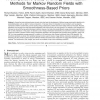Free Online Productivity Tools
i2Speak
i2Symbol
i2OCR
iTex2Img
iWeb2Print
iWeb2Shot
i2Type
iPdf2Split
iPdf2Merge
i2Bopomofo
i2Arabic
i2Style
i2Image
i2PDF
iLatex2Rtf
Sci2ools
PAMI
2008
2008
A Comparative Study of Energy Minimization Methods for Markov Random Fields with Smoothness-Based Priors
Among the most exciting advances in early vision has been the development of efficient energy minimization algorithms for pixel-labeling tasks such as depth or texture computation. It has been known for decades that such problems can be elegantly expressed as Markov random fields, yet the resulting energy minimization problems have been widely viewed as intractable. Recently, algorithms such as graph cuts and loopy belief propagation (LBP) have proven to be very powerful: For example, such methods form the basis for almost all the top-performing stereo methods. However, the trade-offs among different energy minimization algorithms are still not well understood. In this paper, we describe a set of energy minimization benchmarks and use them to compare the solution quality and runtime of several common energy minimization algorithms. We investigate three promising recent methods--graph cuts, LBP, and tree-reweighted message passing--in addition to the well-known older iterated conditiona...
| Added | 14 Dec 2010 |
| Updated | 14 Dec 2010 |
| Type | Journal |
| Year | 2008 |
| Where | PAMI |
| Authors | Richard Szeliski, Ramin Zabih, Daniel Scharstein, Olga Veksler, Vladimir Kolmogorov, Aseem Agarwala, Marshall F. Tappen, Carsten Rother |
Comments (0)

